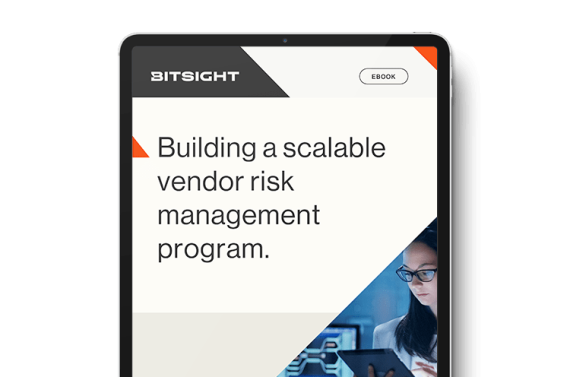Is your business adopting vendors faster than you can address their security issues? Get the keys to scaling your Vendor Risk Management program, from assessment to ongoing monitoring, and proactively mitigate risk in an ever-expanding third-party network.
How to Scale a Cybersecurity Program Across the Expanding Attack Surface

New security vulnerabilities are emerging every day. The number of new disclosed cyber vulnerabilities jumped 25 percent in 2022, and the number of known exploited vulnerabilities—ones observed to be exploited by malicious actors in the wild—nearly doubled from 2021 to 2022.
Remediating vulnerabilities rapidly and effectively reduces the likelihood of your organization becoming the victim of a cyber attack. Consider:
- The risk of ransomware increases sevenfold for organizations that are slow to patch their software and systems.
- Misconfigured systems and TLS/SSL configurations are also a strong indicator of risk. Poor performance in this area increases ransomware risk by four and three times respectively.
- As your vendor ecosystem increases so does your attack surface. The SolarWinds, Kaseya, and other third-party data breaches highlight how a vulnerability in just one organization in your supply chain can have costly and regulatory impacts.
- Despite the risks, new Bitsight research shows that vulnerability management programs are struggling to keep pace with the rate at which new vulnerabilities are discovered.
These risks increase as your business grows, digitally transforms, and enters into more and more vendor relationships. Today, 79 percent of businesses say they are adopting technologies faster than they can address related security issues, and 73 percent have experienced at least one significant disruption caused by a third-party.
Therefore, it’s critical that your cybersecurity program can scale to meet the new demands set forth by this exploding landscape.
Let’s look at three essential tips that can help you scale your cybersecurity program.
1. Move towards continuous monitoring
Threat actors never sleep. They are always probing your network and that of your third parties for vulnerabilities and weaknesses. As you scale your cybersecurity program, it’s critical that you invest in continuous monitoring.
Automated, continuous monitoring allows you to see your attack surface the way the bad guys do – on-premises, in the cloud, and across your supply chain. For instance, the Bitsight solution keeps a constant check on emerging risks, such as open ports, misconfigured and unpatched systems, exposed credentials, and compromised systems – within a single, integrated dashboard. You’ll receive alerts in near real-time the moment risk is detected. You can also share Bitsight’s findings with vendors for more collaborative risk reduction.
By being proactive and hyper aware of your organization’s evolving attack surface – new vendors, new vulnerabilities, new endpoints, and human behavior – you can move quickly to remediate risk.
2. Embrace automation
Manual risk assessment processes are no match for a growing organization. For example, current methods of vendor risk management (VRM), such as point-in-time security assessments and spreadsheet-based security questionnaires, are manual, time-consuming, and hard to scale across your vendor portfolio.
With more suppliers entering the digital supply chain, a rise in third-party hacks, and increased regulation, it’s essential that you find a way to automate and reduce manual and repetitive work.
Consider a fully integrated solution, like Bitsight Vendor Risk Management (VRM), which combines workflow automation with objective data to evaluate third-party vendors and helps you work smarter, not harder. With Bitsight VRM, you can:
- Automate the assessment process and reduce dependency on email follow-up, spreadsheets, calendar reminders, and so on.
- Layer in independent validation of vendor responses using security ratings so that you can automatically understand a third parties’ true security posture and detect red flags in their responses.
- Use custom security questionnaires to understand your vendors’ alignment with security certifications, cybersecurity frameworks, and regulations – specific to your industry.
Read more about how Bitsight can help you build a scalable VRM program.
Bitsight also offers tools that enable you to automate and scale your internal cybersecurity program. With Bitsight for Security Performance Management (SPM), you can centralize critical security automation, monitoring, and risk-reduction functions through a single pane of glass.
3. Put the right metrics in place
Security and risk management executives are being asked to present to the board of directors on the state of their programs — and those of their third parties. But they face two key challenges:
- Speaking the same language: Executives aren’t always familiar with technical metrics or jargon, while security managers often aren’t connecting cyber risk to real world business outcomes the C-suite cares about.
- Lack of VRM analytics: Traditional VRM programs don’t provide analytics to measure their performance. For example, executives want to know how the organization’s vendor ecosystem has evolved, how many risk assessments and periodic evaluations are being conducted, what are their findings, and, ultimately, how much risk was reduced as a result of the program.
Bitsight helps you address these concurrent challenges in three ways.
First, use Bitsight Security Ratings for a data-driven measurement of enterprise-wide security performance. Findings are presented as a numerical score – much like a credit score – so you can convey risk to non-technical stakeholders in straightforward terms.
Next, layer in Bitsight Financial Quantification (part of Bitsight SPM) to understand your financial exposure across various cyber events, such as ransomware attacks, data breaches, and more. By transforming the technical side of cybersecurity into financial language, you can guide leadership discussions around risk management and justify resources and technology investments.
Finally, use Bitsight VRM to convey the value of your third-party risk management program in terms of productivity, efficiency, and effectiveness. Quickly pull metrics that show:
- The number of due diligence engagements and risk assessments performed
- Number of third-party incidents managed
- Manual workload reduction through automated VRM
- Security rating improvements across the vendor portfolio
- Number of vendors whose contracts have been updated to include cybersecurity standards and SLAs
- Reduction of annual loss expectancies over time due to TPRM activities
Read more about Bitsight Executive Reporting.
Let Bitsight help you scale your cybersecurity program
Whether you're just getting started or taking your security program to the next level, don’t let the size of your organization or vendor ecosystem get in the way of identifying, quantifying, and reducing cyber risk. Bitsight has the tools and services to help you solve complex cyber risk challenges – automatically and at scale.



